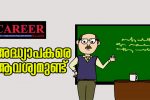Q & A for Degree Level exams

Questions and answers based on Indian History, Kerala History , World History and General Knowledge , based on previous question papers and PSC Question Bank, for graduate level exams. Our experts, Career Team, prepared following model questions and answers. You can study and check your efficiency by practicing Mock Examinations in this site that will be helpful to you. You can make enough revisions to obtain qualified marks in the exam easily.
1. Which among the following is not a work of Pandit Karuppan?
(A) Anandasutram (B) Lankamardanam
(C) Sthothramandaaram (D) Acharabhooshanam
Ans : A
2. Consider the following pairs:
Organization – Founder
1. Vidyaposhini – Sahodaran Ayyappan
2. Ananda Maha Sabha – Vagbhadananda
Which of the pairs given above is/are correctly matched?
(A) 1 only (B) 2 only
(C) Both 1 and 2 (D) Neither 1 nor 2
Ans : A
3. Consider the following statements:
1. She was nominated to Cochin legislative assembly to advise about the Namboothiri Bill.
2. She was an elected member of Malabar District Board
3. She was related with Paliyam Satyagraha
4. She wrote the book ‘Akalathiruttu’.
Which among the above statement/statements regarding Arya Pallom is/are correct?
(A) 1 only (B) 1 and 2 only
(C) 1, 2 and 3 only (D) All of the above
Ans : C
4. The Kerala Panchayat Raj Bill 1994 was passed by the assembly during the tenure of which Minister for Local Administration:
(A) M.K. Munir (B) C.T. Ahammadali
(C) V.J. Thankappan (D) K. Balakrishna Pillai
Ans : B
5. Regarding the second coalition ministry of EMS Namboothiripad, consider the following statements:
1. The Ministry took office in the year 1966.
2. It consisted of CPI(M), CPI, the Muslim League, the RSP, the Karshaka Thozhilali Party and the Kerala Socialist Party.
3. C.H. Muhammed Koya was the Minister for Education.
Which of the above statements are correct?
(A) 1 and 2 (B) 1 and 3
(C) 2 and 3 (D) None of the above
Ans : C
6. Which among the following political parties participated in the Vimochana Samaram?
(A) PSP (B) RSP
(C) None of the above (D) Both of the above
Ans : D
7. Name the first MLA who lost the seat as a result of a court order.
(A) Bhargavi Thankappan (B) M. Umesh Rao
(C) Rosamma Chacko (D) Rosamma Punnose
Ans : D
8. Which kingdom had matriarchy in South India?
(A) Pandya (B) Chera
(C) Pallava (D) Chola
Ans : A
9. Which script was introduced in South India by Ashoka?
(A) Prakrit (B) Pali
(C) Brahmi (D) Kharosthi
Ans : C
10 . Mark the correct statement:
1. “Mughal rule began and ended at Panipat”.
2. Marathas were defeated in the Third Battle of Panipat.
3. French rule began with Panipat.
4. French power ended with Panipat.
(A) 1 is correct. (B) 2 is correct.
(C) Both 1 and 2 are correct. (D) None of the above
Ans : C
11 . Growth of vernacular literature in Medieval India was the greatest contribution of
(A) Vijayanagar Kingdom(B) Bahmani Kingdom
(C) Bhakti movement saints (D) Sultans of Delhi
Ans : C
12 . Mark the correct statement:
1. Nizamuddin Auliya was the contemporary of Muhammad Tughluq.
2. Tulsidas was influenced by Shaikh Salim Chishti.
(A) 1 only (B) Both 1 and 2
(C) 2 only (D) Neither 1 nor 2
Ans : A
13. Which ruler of South India planted the Tree of Liberty?
(A) Tipu (B) Haider Ali
(C) Prataparudra Deva (D) Dost Muhammad
Ans : A
14. Mark the incorrect statement:
1. Ashtapradhan is associated with Shivaji.
2. Shivaji was the organiser of Maratha Rajya.
3. Sulh-i-kul was the idea of Shivaji.
4. Treaty of Purandar took place with Shivaji.
(A) 1 is incorrect. (B) 2 is incorrect.
(C) 3 is incorrect. (D) All are incorrect.
Ans : C
15. Mahmud Gawan was the minister of
(A) Bahmani Kingdom (B) Vijayanagar
(C) Bidar (D) Berar
Ans : A
16. Which ruler used marble in his buildings?
(A) Akbar (B) Jahangir
(C) Shah Jahan (D) Aurangzeb
Ans : C
17. Who wrote the book ‘A Nation in the Making’ ?
(A) Sarojini Naidu (B) Jawaharlal Nehru
(C) Abul Kalam Azad (D) S.N. Banerjee
Ans : D
18. Which one of the following events is related with the 2nd World War period (1939-45)?
(A) Moroccan crisis (B) Zimmermann Telegram
(C) Operation Barbarossa (D) The Berlin Blockade
Ans : C
19. Consider the following pairs:
Ideas -Ideology
1. NATO – Capitalism
2. SEATO – Communism
3. NAM Neo-Colonialism
4. AUTARKY – International Trade
Which of the pairs given above are correctly matched?
(A) 1, 2 and 3 only (B) 3 and 4 only
(C) 1 only (D) 2 and 4 only
Ans : C
20. Consider the following statements:
1. The process of victory of anti-colonial struggles and achievement of freedom by colonies came to be known as
decolonisation.
2. These struggles were won only by means of force and violence.
3. Anti-colonial struggles achieved their first success in Africa and then in Asia.
Which of the statements given above is/are correct?
(A) 1 and 2 only (B) 1 only
(C) 1 and 3 only (D) 1, 2 and 3
Ans : B
21. Consider the following statements:
1. The International Labour Organization (ILO) was established after the 1st World War to secure social justice.
2. The ILO was part of the Treaty of Versailles of 1919.
3. The ILO became the first specialised agency of the UN in 1946.
4. India is a founder-member of the ILO.
Which of the statements given above is/are correct?
(A) 1 and 2 only (B) 4 only
(C) 2, 3 and 4 only (D) 1, 2, 3 and 4
Ans : D
22 . With reference to the consequences of the Industrial Revolution, which of the following statements is/are correct?
1. Subjugation of agricultural countries of the world
2. Increased unautomated production
3. Rise in per capita income.
Select the correct answer using the codes given below:
(A) 1 and 3 only (B) 2 only
(C) 2 and 3 only (D) 1, 2 and 3
Ans : A
23 . Consider the following statements:
1. Globalization is an ongoing process starting from the dawn of civilization.
2. Some scholars find origins of globalization in the expansion of imperialism in Asia and Africa by European powers.
3. Globalization came about with the revolution in transport and communication technologies during 19th and 20th centuries.
4. The process of globalization was increasingly felt only in 1970s.
Which of the statements given above is/are correct?
(A) 1 and 2 only (B) 4 only
(C) 2, 3 and 4 only (D) 1, 2, 3 and 4
Ans : D
24 . With reference to the Industrial Revolution in England, which one of the following statements is correct?
(A) Guild System promoted Industrial Revolution.
(B) Greater production of goods resulted in end of factory system.
(C) Manufacturing methods also changed the methods of agriculture.
(D) None of the above.
Ans : C
25 . With reference to the politico-economic theory of Communism, which one of the following statements is not correct?
(A) Marxist ideas of how to change the world was based on a scientific analysis of society through history.
(B) No society can be Socialist before having gone through the stages of Capitalism.
(C) Capitalism itself creates the conditions for the overthrow of the capitalist society.
(D) Karl Marx showed that the material bases of life never determine the nature of society.
Ans : A
26. With reference to the resolution on Partition Plan of Palestine State of 1947, which one of the following statements is correct?
(A) Palestine was under French mandate System after the 1st World War.
(B) The Plan of Partition was recommended by the U.S.A. in 1947.
(C) After this resolution, a civil war broke out and the plan was not implemented.
(D) All the statements are correct.
Ans : C
27. Consider the following statements:
1. In Kerala, the megaliths are burial sites.
2. Iron objects and pottery are the main items found from megalithic burials in Kerala.
3. ‘Pattanam’ is a megalithic burial site.
Which of the above statement/s is/are not correct?
(A) 1 only (B) 1, 2 and 3
(C) 3 only (D) All of the above
Ans : C
28. Which among the following is not related with medicine in Kerala?
(A) Matangaleela (B) Prakriya Sarvaswam
(C) Ashtanga Sareeram (D) Prayoga Samuchayam
Ans : B
29. Consider the following:
1. Mampalli copper plate of Shri Vallabhan Kota is the first record that used Kollam Era.
2. Parthivapuram copper plate refers to the grants of land to ‘Salai’.
3. Jewish copper plate speaks of a grant to Joseph Rabban.
Which of the above statement/statements is/are correct?
(A) 1 only (B) 1 and 3 only
(C) 1, 2 and 3 (D) None of the above
Ans : C
30. Consider the following pairs:
Work Author
1. Kokila Sandesa Uddanda Sastrikal
2. Ascharya Choodamani Saktibhadra
3. Bhashashtapathi Unnayi Varier
Which of the above pairs is/are correctly matched?
(A) 1 only (B) 1 and 2 only
(C) 1, 2 and 3 (D) None of the above
Ans : B
31. With reference to caste system in Kerala, consider the following statements:
1. ‘Mannappedi’ and ‘Pulappedi’ were abolished by Sri Kerala
Varma of Venad by issuing an order.
2. ‘Sankara Smriti’ is a text dealing with caste rules and practices.
3. ‘Channar’ agitation was a caste movement.
Which of the statement/statements is/are correct?
(A) 1 only (B) 2 only
(C) 1, 2 and 3 (D) 1 and 3 only
Ans : C
32. Consider the following:
1. Revathipattathanam was an annual scholarly assembly patronised by Zamorin of Calicut.
2. ‘Kadannirikkal’ is an important aspect of Revathipattathanam.
3. Head of Payyur family was the chief judge of Revathipattathanam.
Which among the above statement/s is/are NOT correct?
(A) 1 only (B) 2 only
(C) 2 and 3 only (D) 1, 2 and 3
Ans : B
33. With reference to the evolution of the Malayalam language,
consider the following statement/s:
1. The word ‘Jannal’ came to the Malayalam language from
Portuguese.
2. ‘Diwan’ is a word that came to Malayalam from Arab language.
3. ‘Samkshepa Vedartham’ is the first printed book in
Malayalam.
Which of the above is/are correct?
(A) 1 and 3 only (B) 1 and 2 only
(C) 1, 2 and 3 (D) None of the above.
Ans : C
34. Consider the following:
1. ‘Parahita’ system of astronomy existed in Kerala.
2. Katapayadi system employed letters to denote numbers.
3. ‘Laghubhaskareeya Vyakhya’ is an astronomical work.
Which among the above statement/s are correct?
(A) 1 and 2 only (B) 1 and 3 only
(C) 1, 2 and 3 (D) 2 and 3 only.
Ans : C
35. Which one of the following statements about the Private Bill in Indian Parliament is NOT correct?
(A) It is introduced by any Member of Parliament other than a Minister
(B) Its drafting is the responsibility of the member concerned
(C) Its rejection by the House has no implication on the parliamentary confidence in the government or its resignation.
(D) Its introduction in the House requires seven days’ notice.
Ans : D
36. Which of the following statements are correct regarding the federalism of India?
1. Indian Federation is “an indestructible Union of destructible states”
2. Indian Federation is “an indestructible Union of indestructible states”
3. The term ‘federation’ has nowhere been used in the Constitution
4. The Parliament can make laws on any matter in the State
List for implementing the international treaties, agreements or conventions
(A) 1, 3 and 4 (B) 2, 3 and 4
(C) 1, 2 and 3 (D) 1, 2 and 4
Ans : A
37. Considering different schedules in the Constitution of India, which of the following pairs are correctly matched?
1. Fifth Schedule : Provisions relating to the administration and control of Scheduled Areas and Scheduled Tribes
2. Sixth Schedule : Allocation of seats in the Rajya Sabha to the States and UnionTerritories
3. Ninth Schedule : Acts and Regulations of the state legislatures dealing with landreforms and abolition of the Zamindari system
4. Tenth Schedule : Provisions relating to the administration
of tribal areas in the States of Assam, Meghalaya, Tripura
and Mizoram
(A) 1, 2 and 3 (B) 1, 3 and 4
(C) 1 and 3 only (D) 1 and 4 only
Ans : C
38. Which of the following statements relating to Right to Property in the Constitution of India is NOT correct today?
1. Right to Property is a Constitutional Right
2. It is not a part of the basic structure of the Constitution
3. It protects private property against executive action but not against legislative action
4. In case of violation, the aggrieved person cannot move the High Court under Article 226.
(A) 2 and 3 (B) 3 and 4
(C) Only 3 (D) Only 4
Ans : D
39. In India, a Bill is not to be deemed to be a Money Bill, if it contains provision for–––––
(A) the imposition, abolition, remission, alteration or regulation of any tax
(B) the imposition of fines or other pecuniary penalties, or the demand or payment of fees for licences or fees for services rendered
(C) the appropriation of money out of the Consolidated Fund of India
(D) the regulation of the borrowing of money by the Union Government.
Ans : B
40. Which among the following statement is NOT correct regarding the election of the Vice-President of India?
(A) The electoral college consists of both elected and nominated members of the Parliament
(B) The electoral college does not include the members of the State Legislative Assemblies
(C) The electoral college includes the elected members of the State Legislative Assemblies
(D) All doubts and disputes in connection with election of the Vice-President are inquired into and decided by the Supreme Court whose decision is final.
Ans : C
41. Which one among the following is added to fundamental duties through the 86th Amendment Act, 2002 of the Indian Constitution?
(A) who is a parent or guardian to provide opportunities for education to his child or, as the case may be, ward between the age of six and fourteen years
(B) to develop the scientific temper, humanism and the spirit of Inquiry and reform
(C) to protect and improve the natural environment including forests, lakes, rivers and wildlife, and to have compassion for living creatures
(D) to safeguard public property and to abjure violence.
Ans : A
42. Which of the following pairs are correctly matched?
1. Swaran Singh Committee : Fundamental Duties
2. Balwant Rai Mehta Committee : Three-tier system of Panchayati Raj Institutions
3. Rajamannar Committee : Two-tier system of Panchayati Raj Institutions
4. Ashok Mehta Committee : Centre-State relations
(A) 1, 2 and 4 (B) 1, 2 and 3
(C) 2 and 3 only (D) 1 and 2 only
Ans : D
43. ‘Per incurium’ judgement means:
(A) judgement stands as a valid precedent
(B) partially allowed decision
(C) having no bindingness in subsequent decisions
(D) rebuttable judgement.
Ans : C
44. Which one of the follolwing is NOT true of the doctrine of necessity as applied in adminstrative hearings?
(A) Administrative decisions not based on sound necessity is justifiable.
(B) Necessity acts as an exception to bias.
(C) The non-application of the doctrine in certain situations would impede justice.
(D) It postulates that every kind of preference made in administrative decisioins and its process need not vitiate an
administrative action.
Ans : A
45. In order to form a new State, which Schedule in the Constitution of India needs to be amended?
(A) Second Schedule (B) Tenth Schedule
(C) Third Schedule (D) First Schedule.
Ans : D
46. As per the Child Labour (Prohibitioin and Regulation) Act, 1986 a ‘week’ means a period of 7 days beginning at midnight of
(A) Sunday (B) Monday
(C) Saturday (D) Thursday
Ans : C
47. ‘Recess’ under Indian Constitutional Scheme means:
(A) interval between prorogation of Parliament and its reassembly in new session
(B) Parliament in session
(C) adjournment of Parliament
(D) dissolution of House.
Ans : A
48. Match the provisions in the Indian Constitution (List-I) with the country from which it is adopted in List-II.
List-I List-II
Constitutional Provisions Constitutions from of India which adopted
1. Concurrent List (a) Australia
2. Suspension of Fundamental (b) Germany
Rights during emergency
3. Method of election of the President (c) Ireland
4. Residual Powers (d) Canada
5. Amendment of the Constitution (e) South Africa
Select the correct match:
(A) 1 (d), 2 (a), 3 (c), 4 (b), 5 (e)
(B) 1 (b), 2 (a), 3 (d), 4 (e), 5 (c)
(C) 1 (a), 2 (b), 3 (c), 4 (d), 5 (e)
(D) 1 (e), 2 (d), 3 (b), 4 (c), 5 (a)
Ans : C
49. Article 300A protects
(A) private property against executive action but not against legislative action
(B) private property against legislative action but not against executive action
(C) private property from both executive and legilslative action
(D) none of the above.
Ans : A
50. ‘X’ cuts a mango tree in a government land and sells the wood for money. He is liable under the Kerala Land Conservancy Act with
(A) a fine of Rs. 200 and imprisonment which may extend to 6 months.
(B) damages of three times the value of the tree and fine of Rs. 500 only.
(C) damages of three times the value of the tree and fine of Rs. 500/- or punishment of imprisonment extending to 6 months.
(D) None of the above.
Ans : C
Mock Exams are important because of the practice they provide. Multiple attempt of Mock Exams help you to revise the entire syllabus in the simulated setting of the actual exam. This way you can remember what you have learned and help to perform well in actual exam. To do Mock Exam Subscribe NOW: https://careermagazine.in/subscribe/
-CAREER TEAM






